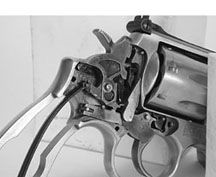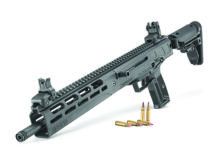.38 Special Defense Loads: Are They Accurate Enough?
re-fragmented self-defense rounds have built-in characteristics that can limit their effectiveness-especially accuracy. But how much does accuracy play a part in your choice of defense ammo? We recently tested a handful of these rounds to see if they were accurate enough to hit what you aimed at.
Our test gun was a concealable small-frame .38 Special revolver, Smith & Wessons Centennial Model 442. The current edition of this J-frame revolver is rated safe for use with the high-pressure (+P) defense rounds. We wanted to find out just how accurate this little gun is and what we could expect from it when firing frangible or pre-fragmented ammunition.
Click here to view “Accuracy Results.”
To establish the accuracy potential of our 442 we first tried shooting groups at 15 yards from a sandbag rest with loads we know are accurate. One load we tried were rounds we had left over from our last NRA Bianchi Cup, a .38 Special load of 3.4 grains of Accurate Solo 1000 powder in a fresh Winchester case, Federal 100 primers and a match-quality 148-grain hollow-based wadcutter slug from Star Bullets. At 15 yards off a sandbag rest (seated position), groups averaged just less than 2 inches from our little 442.
Next up was Black Hills 125-grain standard-pressure hollow points, which had a best group of 1.4 inches, but average group sizes around 2.5 inches.
Defense Load Performance
With the guns baseline accuracy established, we tested the defense loads, Cor-Bons BeeSafe 67-grain soft point, MagSafes 52-grain Defender, and CCIs .38/.357 Shotshells.
CCIs .38/.357 Shotshells, commonly referred to as snakeshot, contained approximately 135 pellets per cup. To test how well the Shotshells penetrated and how far they dispersed, we employed a test barrier of 12 tightly bound sheets of corrugated cardboard covered by duct tape. When we shot the shells at the cardboard, we found the pellet pattern measured 8 inches at 3 yards. Much beyond that distance, even as close in as 5 yards, the pattern dispersed too much to place all the pellets in a torso-sized area, and penetration was substantially reduced. Elevation remained true out to 7 yards, the greatest distance we tested. We didnt chronograph the shotshells for fear of damaging our equipment.
Unlike the CCI shotshells, the rounds from MagSafe and Cor-Bon stay together until impact, increasing their usable range. From 15 yards five-shot groups with the Cor-Bon measured 4.5, 4.75, 4.8, 4.5, and 4.8 inches. The best internal group was four shots at 2.8 inches. The MagSafe groups measured about the same.
So it can be said that at 15 yards, both of these rounds will produce sub 5-inch groups. What bothered us the most, however, was how much point-of-aim changed. Both rounds shot 4 to 6 inches low. At 10 yards the MagSafe and Cor-Bon groups were similar, in the 3-inch range with only a 2.5- to 3.5-inch drop in elevation.
Gun Tests Recommends
Certainly, the strength of all three rounds we tested is close-in fighting. In a previous test (August 1999), we showed how devastating even a small-caliber frangible round can be. These rounds also pride themselves on limiting penetration, protecting the people next door or innocent bystanders beyond the target. But not everyone likes to think of his snubby as a miniature shotgun and may well prefer accuracy at distances longer than the average living room.
In our view, the only way to truly take advantage of the aggressive ballistics offered by defense rounds such as MagSafe and Cor-Bons BeeSafe is to make sure your gun has been properly sighted in and tuned for these radical defense loads. Dont take these extra steps and you might accidently shoot a plant. -Roger Eckstine
———-
Smith & Wesson 686 Update
Ever since we acquired our seven-shot Smith & Wesson model 686 for review in the April 1999 issue of GT, weve been trying to improve upon its design. Even though our staff (and we dare say a quantity of reader mail) voted it one of the Ten Best Guns of the Year in December 1999), we were able to point out at least two areas that needed improvement. For one, the ejector rod on this 2.5-inch barreled revolver was just too short to pump out empty .38 Special cases reliably, let alone the longer .357 Magnums. For another, we found an occasional dead zone in the double-action pull.

To make a longer ejector rod, we asked Carter Custom (870 741-2265 or rosscar@cswnet.com) to install a rod from a 4-inch model. Also, double ball detents added lock up strength, and the front sight blade was shortened from the rear for added sight radius.
The first fix gave us the result we hoped for, sure ejection every time. To solve the trigger problem, we sent this revolver to Kennedy Kustom in Mesa, Arizona, to correct the minor creep we found in the trigger. However, we continued to have problems with the Smith & Wesson 686 misfiring, not being able to detonate even hand-loaded rounds capped with softer Federal small pistol primers.
At that time we were able to solve the problem by turning down the strain screw that adds tension to the hammers mainspring. We reasoned that it had backed out as a result of the percussion from the extremely heavy loads we had fired.
During a subsequent session firing relatively light .38 Special +P ammunition, we again experienced misfires and finally realized that even with the strain screw turned all the way down, this problem would continue. Taking off the grip to inspect the mainspring, we observed that the spring, actually a torsion bar, had been re-contoured with a bend and showed signs of being ground and polished. We theorized that the spring was now so weak that it was no longer able to maintain a constant pressure even at rest. A simple solution would be to replace the mainspring.
To make absolutely certain the answer was just that simple, we decided to let Teddy Jacobson of Sugar Land, Texas (281-277-4008) look the gun over. In sum, he felt the trigger work performed on this revolver was amateurish at best and showed us that lightening the trigger pull had only masked, not cured the original problem. The danger inherent in a mainspring that cannot maintain provide sufficient force to the hammer is obvious, but there is more.
Jacobson found that the trigger return spring, which naturally adds to trigger pull weight, had also been ground. Under a 20X-power lens, the spring showed gouges that even after polishing could lead to the coils snapping, rendering the trigger useless. Though it is a common practice to polish this return spring, it is safer to simply substitute a lighter spring. A better way to facilitate smooth spring action is to polish the channel it rides in. But the culprit in the original problem was the sear. This is a part that in the earlier design Smith & Wesson revolvers rode on a stud, or axle. Todays design relies upon an exact fit with the help of a small coil spring. As Jacobson put it, the original part was cut too small and would get out of position occasionally to create a hesitation in the trigger pull. A by-product of this was the sear spring had kinked, amplifying the problem.
When Kennedy Kustom went in and polished the sear and related surfaces, this only increased the unwanted play even more. Jacobson replaced the sear with a Smith & Wesson factory replacement part purchased from Brownells. The sear spring and trigger return springs were also replaced with Wolff products from Brownells plus a special mainspring, Wolfs Power Rib design.
The original strain screw was replaced with an Allen screw that would not be limited in its adjustment by a head and showed teeth on its blunt end to dig in and hold on to the surface of the mainspring. This is a Teddy Jacobson Actions by T product. When we first handed our unreliable revolver to Jacobson, the double-action trigger-pull weight was 8.25 pounds, even with the strain screw fully applied. We left with it set at 8.75 pounds.
To top off the reconditioning of our model 686, we had Teddy perform one of his re-crowning jobs that left the muzzle shining. A trip to the range with a quantity of PMC .38 Special and Eldorado Starfire .357 Magnum rounds confirmed the improved accuracy and 100 percent reliability of the work. The total price for all the work-ejector rod, trigger job, new parts-was about $300, and worth every penny. -Roger Eckstine
———-
Sprinco Guide Rod Test
In a recent work-over of a Walther P99QA in .40 S&W, we devised a torture test to evaluate an accessory from Sprinco that claimed to reduce felt recoil. In this gun that could be a big help, since the Walthers light weight, coupled with the .40s recoil, make it handful to shoot well.
The Sprinco is merely a two-piece guide rod with outer and inner springs. Having already fired nearly 500 trouble-free rounds in the Walther, including handloads featuring Hodgdon TiteGroup powder and Zero Bullets in twice-fired brass, we devised a rapid-fire test to see whether the Sprinco guide rod would lower our shot-to-shot elapsed time (splits) when hammering the trigger in a close-quarters situation. We used just enough controlled press to land all shots on a common sheet of loose-leaf paper at 7 yards.
For this test we chose Magtechs 180-grain FMJ rounds that we judge to be one of the better inexpensive cartridges available today. The MagTech rounds chronographed at 979 fps, so they were not soft target loads by any means. Data was collected over 20 five-shot strings, first utilizing the standard guide rod and spring and then with the Sprinco assembly installed. With standard equipment in place, average splits ranged from 0.19 to 0.38 seconds for an average of 0.23 second. With the Sprinco guide rod in place, split times ranged from 0.19 to 0.33 seconds for an average of 0.23 second. Adjusting the data to exclude the highs only served to turn the tables in favor of the original equipment 0.218 to 0.221 seconds on average.
Gun Tests Recommends
At this power factor (176) the Sprinco Guide rod was ineffective, in our view. In a previous firing session where handloads with 180-grain bullets traveling only 861 fps (a 155 power factor) were featured, we felt control was enhanced, enabling us to knock down steel plates faster than with the standard guide rod assembly in place. However, we conclude that when firing factory ammunition of the standard or +P variety, the original equipment was our best bet.






























